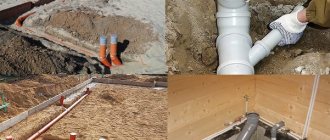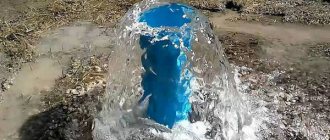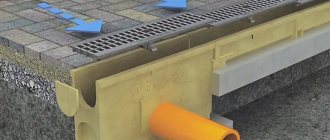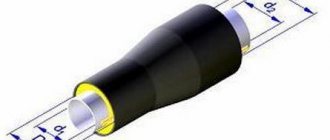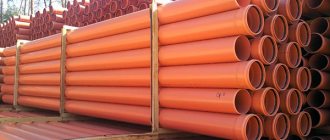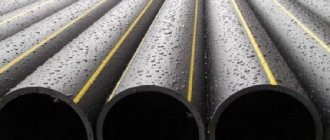- What is soil freezing
- Types and characteristics of land
- Soil table
- Factors of influence
- Regional regulatory depth
- Soils for well construction
- How to secure a well
- Installation of brackets and anchors
- Insulation of the mine and water pipeline
Future owners and those who already own their own well are faced with the problem of normal functioning of the source; one of the difficulties is operation in winter.
What is soil freezing
Soil freezing - expansion of the soil, compaction of the earth due to the conversion of moisture into ice crystals. The process itself occurs differently, depending on the type of land, region, and depth. This factor affects the functioning of the well; frozen soil causes horizontal and vertical displacement of the concrete rings. If there are cracks or breaks in the formwork, water penetrating into them freezes, bursting the concrete, which will lead to expensive repairs.
Building regulations
Construction norms and rules (SNiP) are a set of regulations that regulate the activities of builders, architects and engineers. The information contained in these documents allows you to erect a durable and reliable building or correctly lay a pipeline.
The map, with numbers of soil freezing depth marked on it, was created back in the USSR. It was contained in SNiP 2.01.01-82. But later, SNiP 01/23/99 was created to replace this regulatory act; the map was not included in it. Now it is only available on websites.
SNiP containing information about the depth of soil freezing are numbered 2.02.01-83 and 23-01-99. They list all the conditions on which the degree of frost impact on the soil depends:
Map of standard soil freezing depth in different regions of Russia
- the purpose for which the structure was erected;
- design characteristics and load on the foundation;
- depth of communications;
- location of the foundations of neighboring buildings;
- current and future topography of the development area;
- physical and mechanical soil parameters;
- features of overlays and number of layers;
- hydrogeological characteristics of the construction area;
- seasonal depth to which the ground freezes.
It has now been established that the use of SNiP 2.02.01-83 and 23-01-99 to determine the depth of soil freezing gives a more accurate result than using values taken from a map, since they take into account more conditions.
It should be noted that the calculated degree of impact of low temperatures is not equal to the actual one, since some parameters (groundwater level, snow cover level, soil moisture, sub-zero temperature parameters) are not constant and change over time.
Real ground freezing
This is interesting: GOST designations for welds in drawings
Types and characteristics of land
From the diversity of land cover, we highlight the main ones with opposite characteristics:
- Loam - 60-70% consists of clay layers with admixtures of wet sand. This type of cover has low plasticity.
- Sandy loam is loose soil consisting of sand particles with a small concentration (5-15%) of clay particles. Probably the most common option in the Moscow region.
- Peat, bulk layers - are located in former riverbeds and reservoirs. On these types of cover, the construction of wells, their deepening, and subsequent operation is problematic, this happens due to the plasticity that provokes deformation of the rings and water pipes from the hydraulic structure.
- Saturated clay - like the previous type, clay is characterized by plasticity and the ability to accumulate moisture and water. Water freezing in the soil causes heaving, putting pressure on reinforced concrete rings and water supply pipes if they are installed above the freezing level of the ground.
- Pebbly, coarse-grained soils are an ideal foundation for constructing a well. This type of cover will reliably fix the position of the mine and the equipment connected to it. Such rocks in Moscow, the Moscow region and the Moscow region are found in no more than 10% of areas, and the depth of water deposits, in most cases, is deeper than the statistical average.
There are several methods for determining the type of land.
One of the easy ones that can be done right now is to dig four holes around the perimeter of the area, 50-60 centimeters deep, and compare them with the table in the picture. Why exactly are four holes needed around the perimeter? The site may consist of different types of soil, and it is possible that you will have different types of soil at different ends of the territory.
Excerpts from SNiP
Construction norms and rules (SNiP) are the legal framework for engineers, builders, designers, architects and individual developers. Based on the basic provisions and requirements of this documentation, it is possible to build a truly high-quality and durable structure.
The depth of soil freezing, the map of which is located below, was developed by engineers and geologists back in the Soviet Union, but it is still successfully used today.
Depth of seasonal soil freezing
In order to correctly calculate the foundation, it is necessary to be guided by the provisions set out in SNiPs 2.02.01-83 “Foundations of buildings and structures”, 23-01-99 “Building climatology” and a number of other technical regulations. According to these documents, the standard SNiP soil freezing depth depends on the following conditions:
- Purpose of the building;
- Design features and total load on the base;
- The depth at which utilities are laid and the foundations of nearby buildings are laid;
- Existing and planned topography of the development area;
- Engineering and geological conditions of the project (physical and mechanical parameters of the soil, the nature of the strata, the number of layers, weathering pockets, karst cavities, etc.);
- Hydrogeological conditions of the construction area;
- Seasonal depth of ground freezing.
Depth of soil freezing in the Moscow region
Freezing table for various soil types
| Type of soil | Gap to groundwater in winter | The occurrence of a pipeline from a well or the foundation of a house |
| Rocky and semi-rocky | Any | Any, regardless of depth |
| Gravelly sands, coarse and medium | Any | Regardless of depth, but not less than 0.5 meters |
| The sands are fine and dusty | More than 2 meters below the freezing level | More than 2 meters below the freezing level |
| Sandy loam | Exceeds the calculated level of soil freezing by less than 2 meters | Not less than 3/4 of the calculated cover depth, but not less than 0.7 meters |
| Loams, clays | Less than design depth | Not less than the calculated level |
Important factors when laying a foundation
When constructing the foundation for the planned construction, you need to consider:
Name
- the weight of the foundation pressing on the ground;
- degree of soil resistance;
- pushing force during heaving;
- tangential forces;
- the height of the foundation being raised by heaving force;
- depth of groundwater passage;
- How long does the ground freeze in winter?
Neglecting to carry out calculations can provoke irreparable problems.
Factors of influence
The level of freezing is affected by the following natural indicators:
- Vegetation on the site;
- Snow cover layer;
- Surface temperature;
- Surface type;
- Soil moisture intensity.
At zero degrees, pebble and coarse soils freeze. Fine-grained types freeze at lower temperatures, fine-grained layers consist of small veins, and accordingly, they absorb a larger amount of liquid.
Averaged data, with identical daytime temperatures, the depth is as follows:
- Loams - 130-140 centimeters;
- Clay, bulk layers 135-145 centimeters;
- Pebble soils - 172-176 centimeters;
Effect of snow cover thickness
According to SNiP, the value of freezing depth also depends on the thickness of the snow layer that lies on a given soil in winter. The graph of this dependence is well illustrated in the graph below.
Graph of soil freezing versus snow cover thickness
This circumstance goes logically contrary to the generally accepted procedure for clearing the area around the house from snowdrifts. People, trying to restore order, without realizing it, create a zone of uneven soil freezing on their site. This can damage the foundation, the ground under which can freeze very much and begin to deform the foundation.
With additional insulation of a shallow strip foundation, it is not afraid of frost deformations
In order to create additional insulation of the foundation, as a tip, it will help to plant a low shrub around the perimeter of the house, which will be able to collect snow and protect your foundation from the cold.
3.7 / 5 ( 4 voices)
Regional standard freezing depth
| Region | Loams, clays | The sands are fine and dusty | Sands are gravelly, medium | Pebble soils, coarse-grained |
| Moscow | 1,35 | 1,64 | 1,76 | 2,00 |
| Dmitrov | 1,38 | 1,68 | 1,80 | 2,04 |
| Vladimir | 1,44 | 1,75 | 1,88 | 2,12 |
| Tver | 1,37 | 1,67 | 1,80 | 2,03 |
| Kaluga | 1,34 | 1,64 | 1,75 | 1,98 |
| Tula | 1,34 | 1,63 | 1,74 | 1,98 |
| Ryazan | 1,41 | 1,72 | 1,84 | 2,09 |
| Yaroslavl | 1,48 | 1,80 | 1,93 | 2,19 |
| Vologda | 1,50 | 1,82 | 1,95 | 2,21 |
| Nizhny Novgorod | 1,49 | 1,81 | 1,94 | 2,20 |
| Saint Petersburg | 1,16 | 1,41 | 1,51 | 1,71 |
Soils for well construction
The construction of a new well is not a cheap undertaking; at the initial stages it is important to take into account the nuances of construction and operation that cannot be eliminated later. If the water deposits are close to the surface, any type of soil will do. If the site is located on peat or silt, the depth of liquid deposits is below ten meters and the freezing level is about two, strengthening the structure of the mine and insulating the walls of the source will be required.
The best soil cover for digging is rocky, medium and coarse sand, with a shallow freezing depth.
Breed advantage:
- The soil is not subject to heaving;
- Does not freeze;
- Does not deform;
- It washes away and does not wash away.
The rock problem is that working on this type of soil requires the time and experience of well workers.
When digging a hydraulic structure, a significant factor is the groundwater level; it must be below the freezing depth. When the liquid is higher, it will freeze, which will lead to heaving of the earth layers; this happens unevenly, which leads to deformation or partial displacement of the concrete rings.
If your participant is located on the following types of soil: silty and fine sand, loam and sandy loam, you need to determine the level of groundwater before constructing the source.
To identify such covers, use the following method: throw a fragment of earth into water, does it quickly turn into a liquid substance? - such soil will sag when wet and easily succumb to the influence of icy soil. With this type of land, it is necessary to strengthen the structure of the well.
Snow on the site also affects the depth of freezing. The more it is, the more heat underground and the higher the temperature of the earth cover.
Main characteristics of the bases
Since all soils have different densities and structures, they behave differently when exposed to water and temperature changes.
Rocky rocks are practically not subject to structural changes due to climatic influences, since their base is solid stone. These are convenient to use directly as a foundation after preliminary leveling and preparation.
Cartilaginous soils are a mixture of earth, sand, clay and a significant amount of stones and gravel. Their peculiarity: they are less susceptible to leaching, since they drain water well.
Sandy soils are a reliable foundation, provided that they do not contain dust and fine fractions. During the shrinkage process of the house, significant compaction and subsidence of the soil occurs, but there are practically no heaving processes in it.
Loams and sandy loams are suitable for construction only in some cases with certain characteristics. For such soils, it is extremely important to choose the right foundation, since significant heaving occurs when the rocks harden.
Clay rocks are the most difficult foundations to construct: they expand in winter and are subject to active movement under the influence of water. A house on clay soil can “walk”, so the foundation must be selected extremely carefully.
How to secure a well
To protect the well from possible problems when the soil freezes and soil heaves, the way out is to strengthen the structure of the shaft.
- Using fragmentary bracketing of concrete rings;
- Installation of metal plates along the entire height of the shaft;
- Insulation of the mine to the freezing level.
If you have water supply from a well, the pipes must be located below freezing point.
Methods of protection against frost heaving
There are many ways to prevent the destructive effects of frost heaving.
Year-round heating of buildings
If the temperature in the building is planned to be maintained within 15 degrees throughout the year, a shallow strip or floating slab foundation can be used as the foundation.
In this case, a completely closed, windproof base is erected, followed by insulation along the outer perimeter.
The insulation is extruded polystyrene foam. Its thickness for the central region should be 50-100mm. The same material is used to insulate blind areas to a width of more than 1.2 meters or the level of soil freezing. Following these recommendations will reduce the degree of heaving by 80%.
Drainage
The purpose of the system is to remove melt or rainwater from the building and drain the area. A stormwater system is a whole drainage complex that contains a blind area, gutters, and storm gutters that drain water away from the building. This is one of the ways to reduce soil freezing and the severity of frost heaving.
Installation of brackets and anchors
To ensure stability and strength to the water source trunk, to prevent displacement of well rings and to prevent the formation of vertical breaks, staples are carried out, that is, rigid joints of reinforced concrete joints with anchors and metal staples. The structure is also fastened both during construction and at existing sources (as one of the stages of preventive and repair work).
Fixation can be done in two ways - by installing rings with a lock and staples. Locking rings are able to withstand lateral soil pressure, but do not solve the problem of vertical ruptures. Without staples, some rings may shift during soil movement, resulting in a curvature of the shaft.
How are the rings fastened?
For installation, 2-4 staples are used for each joint (the number depends on the installation location). Before installation, holes of the required size are made with a hammer drill on adjacent rings (not far from the seam), into which brackets or anchors are installed, secured with powerful bolts. As a result, the “holder” connects the top of the lower ring and the bottom of the upper one.
Features of high-quality bonding:
- It is advisable to scrape the entire shaft, regardless of the type of soil, to achieve the best stability of the structure;
- Fastening only 2-3 upper joints is not allowed if the well is located on quicksand, sandy soils, or in areas where there is heavy rainfall; in all these cases it is necessary to completely scrape the shaft;
- Fastening work is carried out using special tools, in compliance with safety rules, so you should not go down into the mine without the necessary equipment and without the skills to carry out repair work in the well.
Sewer level
Slightly different rules apply when deciding how deep to bury a sewer pipe in a private house. This system works differently: wastewater is either drained into the septic tank by gravity due to the slope, or is pumped by a pump, so it does not linger in the pipes and there is nothing to freeze in them.
Scheme of an autonomous sewerage system Source www.alta-sib.ru
Insulation of the mine and water pipeline
Well insulation is the process of arranging to retain heat inside the tank. For more information about mine insulation technology, also read why you need to insulate a mine.
If you can insulate a mine after the source has been used, then water supply from a well and pipes is necessary before the water supply.
The trench is dug below the freezing level with a margin of 20-30 centimeters, and heating cable technology is used as insurance. A cable is pulled around the pipe or inside it, to which heat is supplied; this heat helps maintain a constant temperature in the plumbing system.

